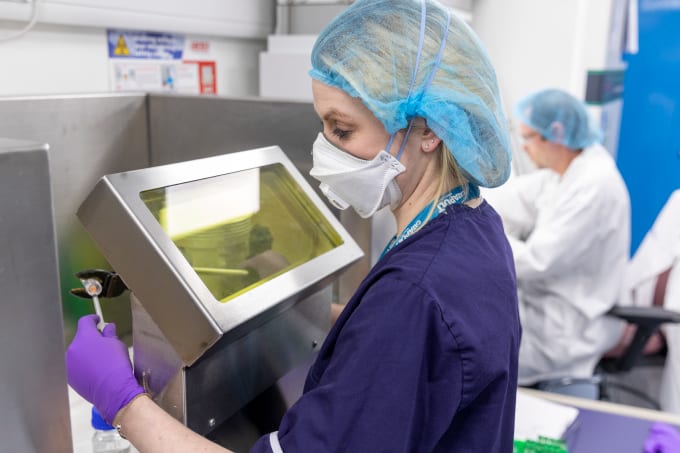
Gelatin has been used in hemostatic procedures for over 80 years, gaining popularity during WWII for frontline battlefield use. It has since become a staple in the medical device industry – an industry that tends to be conservative when it comes to radical changes. With over 20 years of experience in the field, I’ve seen how innovation often takes the form of incremental improvements.
Of course, other materials are available, but they tend not to be as versatile, easy to handle, or as effective as gelatin. Hence why gelatin remains a preferred choice for healthcare professionals. It’s a tried-andtested technology that continues to advance. We’re seeing developments where gelatin is combined with other substances, such as chitosan, a hydrogel polymer, or fibrinogen, a key player in blood clotting. At Gelita, we’ve worked on plasma-activated surfaces using ionic gases, further enhancing the material’s effectiveness. These are highly impactful changes.
When applied to a wound, a gelatin sponge initiates a biomechanical response by rapidly absorbing fluid and concentrating platelets to speed up clotting. Once wet, the sponge becomes pliable, conforming to the wound’s shape while applying gentle pressure. This activates the body’s natural clotting cascade, leading to fibrin formation – much like a cork sealing a bottle. As a protein derived from mammalian collagen, gelatin is extremely biocompatible, making it ideal for medical use. It’s also biodegradable and can be safely left in the body after surgery. To ensure optimal safety and performance, Gelita maintains rigorous manufacturing standards and quality control protocols, especially when working with natural raw materials like bones, hides, and skins.
Gold-standard quality
With gelatin, it is important to control endotoxins, which, particularly from gram-negative bacteria, can cause fever and complications. Although we can’t eliminate these bacteria completely from gelatin, because they exist naturally in animal raw materials, we can suppress their growth. Through the use of clean production environments, sustainable and traceable fresh raw materials, and carefully selected treatments that mitigate bacterial proliferation, we can ensure high-quality production processes, with quality checks implemented throughout the production cycle. Our MEDELLAPRO® line, for example, focuses on endotoxin-controlled excipients. A high purity, endotoxin controlled pharmaceutical grade gelatin that replaces human tissue grafts in blood clotting sponges, implants, wound dressings, bioprinted scaffolds, by nature and drug delivery, MEDELLAPRO® offers exceptional biocompatibility and minimal allergenic risks.
For other uses, such as vaccine stabilization, we produce shorter protein molecule chains under the VACCIPRO® brand. These collagen peptides are often used for vaccine stabilization – trusted by leading manufacturers, VACCIPRO® has been key in multiple vaccine developments. With ultra high purity, precise molecular weight control, low allergenic potential, and exceptional biocompatibility, VACCIPRO® complies with FDA standards. It is the gold standard scaffold for safe, stable liquid, and lyophilized vaccines.
For both, MEDELLAPRO and VACCIPRO, Gelita also ensures traceability according to the related ISO standard. For our products produced in US, we maintain a Drug Master File with the FDA, which our customers can link to their own documentation during regulatory submissions. This kind of support is a distinctive aspect of our approach.
The future of gelatin science
Gelatin’s gelling strength can be fine-tuned, much like you can adjust the firmness of jello or gummy bears. We can therefore produce gelatin that can be used to coat surfaces, or as a nutrient medium in labs for cell culturing. We provide gelatin powder suitable for any use. Our customers can dilute and process the material to suit their own requirements and, from previous experience in manufacturing sponges, I know how the porosity and absorbency properties significantly impact performance. Achieving consistency in pore size, softness, and pliability is a form of art.
As a chemical engineer with patents in wound healing systems, and having observed the deep gratitude of patients for the use of well designed products, that’s the kind of expertise that motivates me – and it aligns perfectly with Gelita’s mission to improve quality of life for those that need our products.
It’s true that the core gelatin technology has not seen many radical changes over the years. Incremental changes, however, are happening. The industry is looking for alternatives to animal-derived materials, for example. Gelita is addressing this trend by biotechnologically developing a recombinant collagen protein using modified yeast, which also qualifies as a non-GMO product. Small batches will soon become available for trials. In this way, Gelita is at the forefront, engineering the future of hemostatic materials, tissue engineering, artificial organs, and vaccine stabilization.







